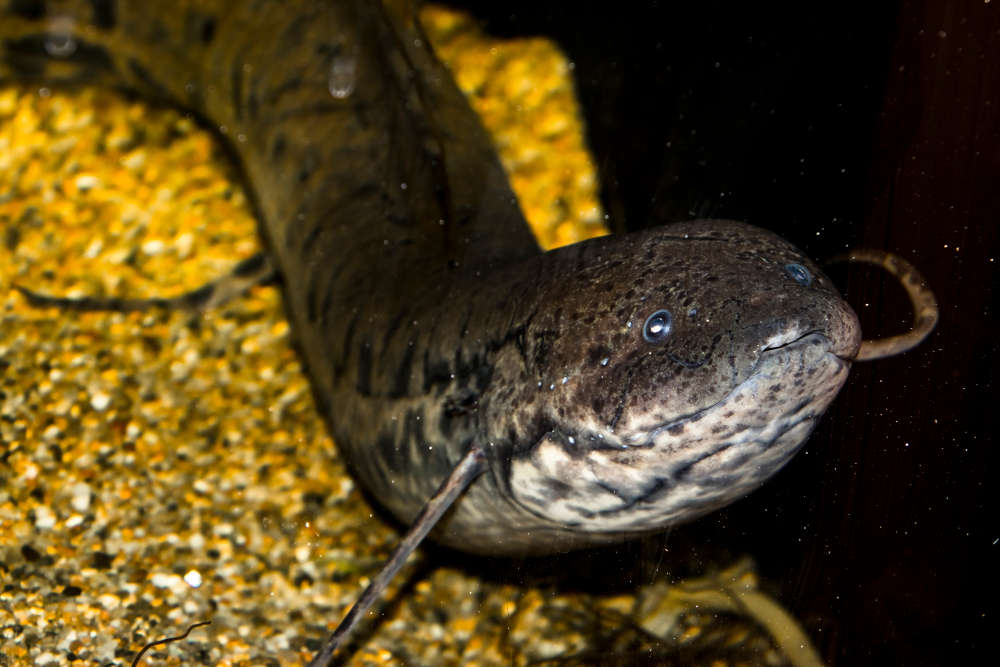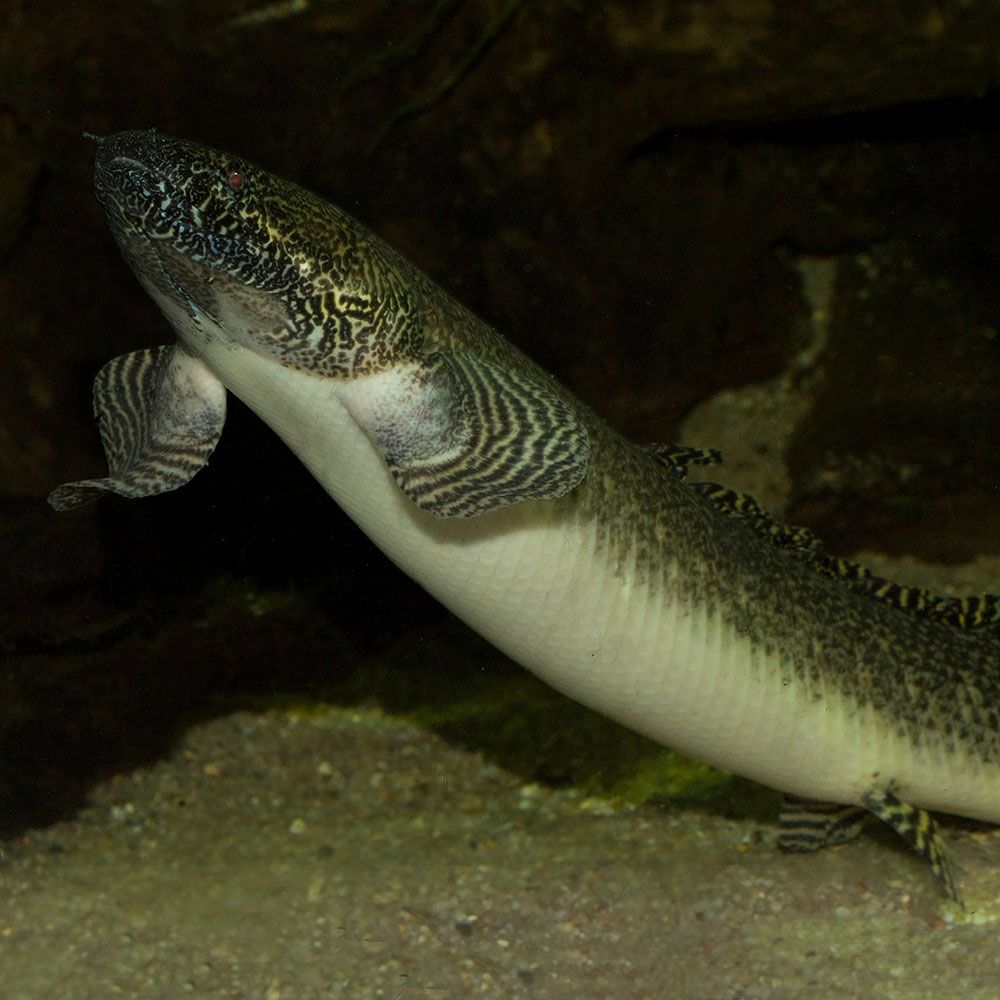A big tank deserves a big fish, and the African lungfish is the go-to choice for many experienced aquarists who share this opinion. This freshwater species neither demands much food nor falls sick often. It is perpetually chilled out in an otherwise empty tank and lives a long life – even outliving the average cat.
Ready to bring these mellow fish home? Here’s the ultimate care guide for the laid-back African lungfish.
What is African Lungfish?
African Lungfish is a big freshwater fish that generally lives longer amongst the other fishes. Below are some of its characteristics:
| Origin | South Africa |
| Order | Lepidosireniformes |
| Family | Protopteridae |
| Scientific Name | Protopterus annectens |
| Common Names | West African lungfish, tana lungfish, mudfish |
| IUCN Red List Status | Least Concern |
| Appearance | Long, eel-like bodies with soft scales and thread-like fins |
| Size | Up to 100 cm (40 in) |
| Lifespan | 20-25 years |
| Temperament | Aggressive and fearless |
| Tank Level | Bottom-dwellers but are known to jump |
| Water Temperature | 76-86 °F (24-30 °C) |
| pH Level | 6-8 |
| Water Hardness | Below 10 dGH |
| Care Level | Intermediate |
| Minimum Tank Size | 60 gallons |
| Tank Environment | Thrive in any tank with minimal water movement |
| Diet | Omnivorous |
| Tank Mates | None; you must house it in a single-species tank |
What is the Natural Habitat of African Lungfish?
African lungfish are natives of South Africa but are found all across the inlands of Africa. They are easy to spot in Mali, Nigeria, Chad, and Sudan. Fishermen also source them from Tanzania and Zambia.
These fish are primarily found resting at the bottom of temporary floodplains. However, they are also spotted in the backwaters of rivers and lakes besides marginal swamps. Their origins are rooted in the tropics, so they like to live in warm water.
The species is listed as Least Concern in the IUCN Red List, which means it isn’t facing any widespread threats – natural or otherwise.
Which family do African lungfish belong?
Bearing the scientific name Protopterus annectens, this species belongs to the Ceratodontiformes order and the Protopteridae family. It is one of the only four members of the Protopterus genus, but they are not rare – quite the opposite. The African lungfish is one of the most sold fish in the aquarium trade.
The species’ three cousins are equally hardy but look starkly different. The marbled lungfish (Protopterus aethiopicus) is arguably the most attractive-looking with its patterned, slender body. The gilled lungfish (Protopterus amphibius) is the shortest one, whereas the spotted lungfish (Protopterus dolloi) is the slimmest.

Since it most commonly appears in West Africa, it earns the name West African lungfish. But many in the aquarium trade also call it the mudfish and the tana lungfish.
Interesting Fact: African lungfish have survived without evolving for nearly 400 million years! No wonder they’re called “living fossils!”
How do African Lungfish look?
These look oddly like an eel, except they have long, thin limbs that allow forward movement. They often use their limbs to “walk,” making them seem like they are hopping across the tank.
They have small eyes but a prominent snout, and their bodies are nearly ten times the length of their head, often longer.
These fish have four fins that double as limbs that they use to “crawl.” Not to mention a tail fin. They also have cycloid scales embedded on their skin.
Typically, these scales are scattered all over the body, with approximately 40 and 50 scales between the operculum and anus, plus about 40 scales around the tailfin.
Also, these have tooth enamel, giving them a nasty bite that can tear apart marine life and even your hand.
What is the size of African Lungfish?
In the wild, both genders of this fish grow to 40 inches in length.
However, in an aquarium, growth is typically limited to over 30 inches. Most stores sell juveniles that are between 10 and 20 inches long, but it’s not hard to find younger (and hence smaller) fish.
What is the color of African Lungfish?
This fish typically has a brown, olive, or slate-grey body. The body always has dark spots or marks, which may be black or brown.
What is the difference between male and female African Lungfish?
There are no physical differences between the males and females.
How do African Lungfish behave?
In my experience, African lungfish hang out unbothered and aloof at the bottom of the tank. They move slowly because they have a slow metabolism in adulthood.
When they see another fish – small or large, or even the opposite sex of the same species – they are quick to attack.
What is the Lifespan of African Lungfish?
The African lungfish can live longer than 20 years. So, this isn’t the right fish for a newbie aquarist or someone not looking for a two-decade-long commitment.
Did you know? The African lungfish has a pair of lungs to breathe air outside of water.
How to Take Care of Western African Lungfish?

Since this species rarely falls sick and doesn’t need to be fed often, many aquarists assume the fish will survive if it isn’t proactively cared for.
But the concept can’t be further from the truth since even these hardy fish demand the right tank, water, and food.
What is the Tank Size Suited for African Lungfish?
An adult fish needs a tank that is at least 72 x 30 x 30 inches with a capacity of 280 gallons. Though the species doesn’t move about much, it does need a lot of space to turn, swim, grow, and feel at home. That said, you can get away with raising a juvenile in a smaller tank about half the size. But remember, lungfish grow fast.
What should be the Water Chemistry for African Lungfish?
Since this species is freshwater, it can be challenging to maintain water chemistry that will keep it healthy.
- pH Levels: 6-8
- Water Temperature: 76-86 °F (24-30 °C)
- Water Hardness: Below 10 dGH
- Ammonia: 0 ppm
- Nitrite: 0 ppm
- Nitrate: Below 10 ppm
Checking the water quality every other week is essential to keeping your mudfish from needlessly falling ill.
What should be the Tank Environment for African Lungfish?
This lethargic, bottom-dwelling fish digs itself a hole every summer in the wild.
So, the ideal tank for this fish will have a substrate, some vegetation, and soft-edged décor. However, the species isn’t picky about its surroundings, so it can thrive in any tank with enough space and the right water conditions.
Substrate
The West African lungfish feel most at home in a tank with muddy, sandy, or extremely fine substrates.
Remember, this species has soft skin, so adding gravel to your tank is a strict no-no. Also, the substrate must be cleaned thoroughly before being added to the tank.
Plants
Being a tropical species, these fish love to hang out around branches, so introducing some driftwood or bogwood roots is an excellent idea. They will hide behind vegetation and prefer hanging out in dimly lit spots.
Bear in mind that adding branches to water changes its pH. So, you must soak the stalks in water for several days (and repeatedly adjust the water) before introducing them to the tank.
Lighting
Low- and medium-intensity lights are the right picks for a tank with a lungfish in it.
Décor
Large rocks and statues with smooth surfaces are a safe décor pick for this soft-skinned species. Avoid putting synthetic coral and caves in their tank.
Remember, these fish might be slow but are inherently land-crawlers and will jump out of a tank. Keep a tight lid on the tank at all times.
Filtration
The African lungfish is a messy eater, so the water in your tank will get dirty rather quickly.
A sump or a large canister filter is essential to keep the water clean and prevent these fish from falling sick. You must use water conditioners and install a heater to maintain the proper water temperature.
They need a 30% water change every two weeks to stay healthy.
Water Flow Rate
The “current” setting on your canister filter or sump must be set to low, as this species lives in slow-moving water.
Fish Care Tip: Leave at least six inches between the water and the tank lid so the fish can come up for air.
What do African Lungfish eat?
Being an omnivore, these fish are a natural predator of other fish and amphibians.
In aquariums, they are known to enjoy worms, insects, prawns, and mussels. Algae wafers make for good snacks, and they will even eat pellet food.
Juveniles must eat twice daily, while adult mudfish must be fed whole fish such as trout and sprats twice weekly. They don’t hesitate to bite, so feed them with tongs.
What are the Tank Mates for African Lungfish?
African lungfish are unpredictable around other fish and will gobble up a tank mate anytime it feels like it. It is fearless and will not hesitate to square off with a larger fish or the opposite sex. Never put a fish you care about in a tank with this natural-born savage.
What are the Common Diseases for African Lungfish?
African lungfish are some of the toughest fish money can buy. They rarely fall sick, and there’s only one common disease that can impact them:
| Disease Name | Causes | Symptoms | Treatment |
|---|---|---|---|
| Ich | Parasitic infestations, poor water conditions | White spots on body and fins, flashing, lethargy | Medications with malachite/formalin, raising water temperature |
Quick Tip: Keeping a close eye on water quality and making timely adjustments virtually guarantees this species’ good health.
Breeding & Reproduction of African Lungfish
Though scientists have extensively studied this species, breeding hasn’t yet been achieved in captivity. But these fish are surprisingly efficient at raising fry in the wild.
In their natural habitat, these fish pair up and build a nest in the mud and line their insides with plant matter. Then, females lay the eggs in the nest. Next, males fertilize the eggs and guard their babies fiercely for about two months. In this period, the eggs hatch, the tadpole grow, and eventually lose their newt-like gills.
Where can you buy African Lungfish?
Being a high-maintenance species that demands a massive tank, these are easy for stores to neglect. Never buy these fish out of a dirty tank. It’s better to find a juvenile since you can request to see it eat twice daily. If it is quick to eat, you can be sure it’s a healthy fish. You can buy them online, but ensure you purchase from a reputed website.
A word from FishInAquarium
Got what you need out of this read? An African lungfish is the perfect companion for an experienced aquarist wanting to commit to their hobby long-term. If that’s you, and maintaining water quality is second nature to you, you should bring one of these fish home.
If you liked this article, consider sharing it with other aquarists and bookmark our page for all things fishkeeping.


